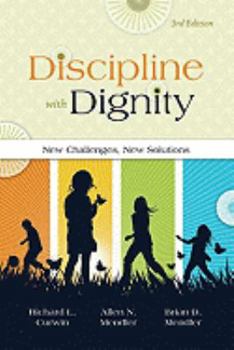Discipline With Dignity: New Challenges, New Solutions
Select Format
Select Condition 
Book Overview
PLEASE PROVIDE COURSE INFORMATION PLEASE PROVIDE This description may be from another edition of this product.
Format:Paperback
Language:English
ISBN:1416607463
ISBN13:9781416607465
Release Date:November 2008
Publisher:Association for Supervision & Curriculum Deve
Length:251 Pages
Weight:0.86 lbs.
Dimensions:1.0" x 6.0" x 8.8"
Customer Reviews
5 ratings
Very Pleased
Published by Thriftbooks.com User , 15 years ago
The book came in a reasonable amount of time and there was no damage to the book. It was priced fairly and was in great shape.
This book changed my life.
Published by Thriftbooks.com User , 15 years ago
If you only read one book about teaching, read this one. If you read two books about teaching, read this one twice. I read this for the first time in the middle of my sixth year of teaching and it changed my classroom more than anything else I have ever tried. On the surface the message of this book seems obvious: treat students with respect and they will treat you with respect. But anyone who has been in front of a classroom knows that it isn't that simple. This book gives you the why and the how. It walks you through the steps, and the authors clearly know what it is like to be a teacher. The new edition includes important updates that make the book even more relevant to teaching today. It also includes a section at the end of each chapter for administrators. If you want even the students who are failing your class to know that you care about them as individuals, even the kids who you give detention to to say you are their favorite teacher, even the totally checked out kids to check in every once in a while, then you need to read this. I can't guarantee that it will change your life, but it did change mine.
A Consequence-Centered (Not Punishment-Centered) Approach to Handing Student Misbehavior
Published by Thriftbooks.com User , 16 years ago
I once attended a seminar by author Richard Curwin and found him to be an affable fellow with good insights to classroom management. This book contains many practical tips in this regard (review based on the 1989 edition). Curwin believes that classroom discipline is a social contract that should jointly be planned by teacher and students. This includes small details. For instance, teacher and students should come up with a consequence for dealing with an infraction in which the teacher doesn't know who did it, but not one that stigmatizes the entire class. Curwin notes that the student population breaks down 80%/15%/5% in terms of near-complete compliance, varied compliance, and chronic non-compliance to rules. He summarizes the challenge facing teachers: "In many junior and senior high classes, 5 to 10 minutes of class time is wasted at the beginning of class trying to focus the attention of students. At least another 5 to 10 minutes is directed toward off-task behavior (students not paying attention, using put downs, arguing) during class time. This amounts to minimally 10 to 20 minutes of a 45- to 50-minute class period doing things other than what you are paid to do and want to do: teach!" (p. 53). Punishment is centered on retribution, and can violate the dignity of the child. Consequences, in contrast, are corrective. The distinction between the two is not simply semantic. Let's illustrate. A child who didn't bring in homework can be punished by writing 100 times "I will do my homework". How much better to have the child have the consequence of writing out a plan for budgeting his/her time so that the homework gets done? For hitting another person, the child may be punished by having to stay after school. The offender should instead have the consequence of coming after school and writing out a plan for expressing his/her anger at others without hitting. Lee Canter believes that the identical set of consequences should be imposed on anyone who violates a classroom rule. Curwin, in contrast, believes that the teacher should enjoy the flexibility of different consequences for the same infraction. This allows the teacher to avoid choosing between appearing to be rigid and being inconsistent. For instance, if a child didn't do homework owing to a home emergency, he/she can face the consequence of a parent-teacher conference. If he/she didn't do homework for any excusable reason, he/she can face the consequence of coming after school. Power struggles can be avoided by not "taking the hook". If a child says: "You can't make me!", the teacher should ignore it, but then privately tell the child that he/she is expected to follow through. Curwin includes many unconventional ideas for solving discipline problems. For instance, a teacher had a chronic problem with students throwing paper airplanes. She came up with the idea of a bloc of classroom time when students would build paper airplanes and launch them--provided that not a single paper ai
Discipline with Dignity
Published by Thriftbooks.com User , 17 years ago
Great book! Variations of strategy are used today in many school systems. For new teachers, it lays out step by step how to manage your classroom. Both students and teachers benefit from a well managed classroom!
A "must have" for all novice, and experienced teachers
Published by Thriftbooks.com User , 26 years ago
Curwin and Mendler do an exceptional job breaking down classroom management in an easy to read and codified form. The book provides valuable insight into problems and solutions in today's classrooms and also functions well as a quick reference for those topics you may need "on the fly"





